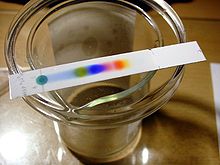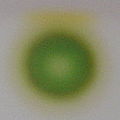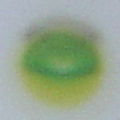- Thin layer chromatography
-
Thin layer chromatography 
Separation of black ink on a TLC plateAcronym TLC Classification Chromatography Other techniques Related Agarose gel electrophoresis
SDS-PAGEThin layer chromatography (TLC) is a chromatography technique used to separate mixtures.[1] Thin layer chromatography is performed on a sheet of glass, plastic, or aluminum foil, which is coated with a thin layer of adsorbent material, usually silica gel, aluminium oxide, or cellulose (blotter paper). This layer of adsorbent is known as the stationary phase.
After the sample has been applied on the plate, a solvent or solvent mixture (known as the mobile phase) is drawn up the plate via capillary action. Because different analytes ascend the TLC plate at different rates, separation is achieved.[2]
Thin layer chromatography can be used to:
- Monitor the progress of a reaction
- Identify compounds present in a given mixture
- Determine the purity of a substance
Specific examples of these applications include:
- analyzing ceramides and fatty acids
- detection of pesticides or insecticides in food and water
- analyzing the dye composition of fibers in forensics
- assaying the radiochemical purity of radiopharmaceuticals, or
- identification of medicinal plants and their constituents [3]
A number of enhancements can be made to the original method to automate the different steps, to increase the resolution achieved with TLC and to allow more accurate quantization. This method is referred to as HPTLC, or "high performance TLC".
Contents
Plate preparation
TLC plates are usually commercially available, with standard particle size ranges to improve reproducibility. They are prepared by mixing the adsorbent, such as silica gel, with a small amount of inert binder like calcium sulfate (gypsum) and water. This mixture is spread as a thick slurry on an unreactive carrier sheet, usually glass, thick aluminum foil, or plastic. The resultant plate is dried and activated by heating in an oven for thirty minutes at 110 °C. The thickness of the adsorbent layer is typically around 0.1 – 0.25 mm for analytical purposes and around 0.5 – 2.0 mm for preparative TLC.[4]
Technique
The process is similar to paper chromatography with the advantage of faster runs, better separations, and the choice between different stationary phases. Because of its simplicity and speed TLC is often used for monitoring chemical reactions and for the qualitative analysis of reaction products.
To run a thin layer chromatography, the following procedure is carried out: [5]
- A small spot of solution containing the sample is applied to a plate, about 1.5 centimeters from the bottom edge. The solvent is allowed to completely evaporate off, otherwise a very poor or no separation will be achieved. If a non-volatile solvent was used to apply the sample, the plate needs to be dried in a vacuum chamber.
- A small amount of an appropriate solvent (elutant) is poured in to a glass beaker or any other suitable transparent container (separation chamber) to a depth of less than 1 centimeter. A strip of filter paper is put into the chamber, so that its bottom touches the solvent, and the paper lies on the chamber wall and reaches almost to the top of the container. The container is closed with a cover glass or any other lid and is left for a few minutes to let the solvent vapors ascend the filter paper and saturate the air in the chamber. (Failure to saturate the chamber will result in poor separation and non-reproducible results).
- The TLC plate is then placed in the chamber so that the spot(s) of the sample do not touch the surface of the elutant in the chamber, and the lid is closed. The solvent moves up the plate by capillary action, meets the sample mixture and carries it up the plate (elutes the sample). When the solvent front reaches no higher than the top of the filter paper in the chamber, the plate should be removed (continuation of the elution will give a misleading result) and dried.
Different compounds in the sample mixture travel at different rates due to the differences in their attraction to the stationary phase, and because of differences in solubility in the solvent. By changing the solvent, or perhaps using a mixture, the separation of components (measured by the Rf value) can be adjusted. Also, the separation achieved with a TLC plate can be used to estimate the separation of a flash chromatography column.[6]
Separation of compounds is based on the competition of the solute and the mobile phase for binding places on the stationary phase. For instance, if normal phase silica gel is used as the stationary phase it can be considered polar. Given two compounds which differ in polarity, the more polar compound has a stronger interaction with the silica and is therefore more capable to dispel the mobile phase from the binding places. Consequently, the less polar compound moves higher up the plate (resulting in a higher Rf value). If the mobile phase is changed to a more polar solvent or mixture of solvents, it is more capable of dispelling solutes from the silica binding places and all compounds on the TLC plate will move higher up the plate. It is commonly said that "strong" solvents (elutants) push the analyzed compounds up the plate, while "weak" elutants barely move them. The order of strength/weakness depends on the coating (stationary phase) of the TLC plate. For silica gel coated TLC plates, the elutant strength increases in the following order: Perfluoroalkane (weakest), Hexane, Pentane, Carbon tetrachloride, Benzene/Toluene, Dichloromethane, Diethyl ether, Ethylacetate, Acetonitrile, Acetone, 2-Propanol/n-Butanol, Water, Methanol, Triethylamine, Acetic acid, Formic acid (strongest). For C18 coated plates the order is reverse. Practically this means that if you use a mixture of ethyl acetate and hexane as the mobile phase, adding more ethyl acetate results in higher Rf values for all compounds on the TLC plate. Changing the polarity of the mobile phase will normally not result in reversed order of running of the compounds on the TLC plate. An eluotropic series can be used as a guide in selecting a mobile phase. If a reversed order of running of the compounds is desired, an apolar stationary phase should be used, such as C18-functionalized silica.
Analysis
As the chemicals being separated may be colorless, several methods exist to visualize the spots:
- Often a small amount of a fluorescent compound, usually manganese-activated zinc silicate, is added to the adsorbent that allows the visualization of spots under a blacklight (UV254). The adsorbent layer will thus fluoresce light green by itself, but spots of analyte quench this fluorescence.
- Iodine vapors are a general unspecific color reagent
- Specific color reagents exist into which the TLC plate is dipped or which are sprayed onto the plate[7]
- Potassium permanganate - oxidation
- Iodine
- In the case of lipids, the chromatogram may be transferred to a PVDF membrane and then subjected to further analysis, for example mass spectrometry, a technique known as Far-Eastern blotting.
Once visible, the Rf value , or retardation factor, of each spot can be determined by dividing the distance the product traveled from the initial spotting site by the distance the solvent front traveled from the initial spotting site. These values depend on the solvent used, and the type of TLC plate, and are not physical constants. Eluent on the thin layer is put on top of the plate
Applications
In organic chemistry, reactions are qualitatively monitored with TLC. Spots sampled with a capillary tube are placed on the plate: a spot of starting material, a spot from the reaction mixture, and a "co-spot" with both. A small (3 by 7 cm) TLC plate takes a couple of minutes to run. The analysis is qualitative, and it will show if the starting material has disappeared, i.e. the reaction is complete, if any product has appeared, and how many products are generated (although this might be under-estimated due to co-elution). Unfortunately, TLCs from low-temperature reactions may give misleading results, because the sample is warmed to room temperature in the capillary, which can alter the reaction—the warmed sample analyzed by TLC is not the same as what is in the low-temperature flask. One such reaction is the DIBALH reduction of ester to aldehyde.
As an example the chromatography of an extract of green leaves (for example spinach) in 7 stages of development. Carotene elutes quickly and is only visible until step 2. Chlorophyll A and B are halfway in the final step and lutein the first compound staining yellow.
In one study TLC has been applied in the screening of organic reactions[8] for example in the fine-tuning of BINAP synthesis from 2-naphthol. In this method the alcohol and catalyst solution (for instance iron(III) chloride) are placed separately on the base line, then reacted and then instantly analyzed.
References
- ^ Laurence M. Harwood, Christopher J. Moody. Experimental organic chemistry: Principles and Practice (Illustrated edition ed.). pp. 159–173. ISBN 978-0632020171.
- ^ Vogel's Textbook of Practical Organic Chemistry (5th Edition) (Hardcover) by A.I. Vogel (Author), A.R. Tatchell (Author), B.S. Furnis (Author), A.J. Hannaford (Author), P.W.G. Smith ISBN 0582462363
- ^ Reich, E.; Schibli A. High-performance thin-layer chromatography for the analysis of medicinal plants (illustrated edition). Thieme: New York, 2007. ISBN 3-13-141601-7
- ^ Tables showing the thickness value of commercial regular and preparative Thin Layer Chromatography plates
- ^ Thin Layer Chromatography: How To http://www.reachdevices.com/TLC.html
- ^ Fair, J. D.; Kormos, C. M. J. Chromatogr. A 2008, 1211(1-2), 49-54. (doi:10.1016/j.chroma.2008.09.085)
- ^ Thin Layer Chromatography stains http://www.reachdevices.com/TLC_stains.html
- ^ TLC plates as a convenient platform for solvent-free reactions Jonathan M. Stoddard, Lien Nguyen, Hector Mata-Chavez and Kelly Nguyen Chem. Commun., 2007, 1240 - 1241, doi:10.1039/b616311d
Categories:
Wikimedia Foundation. 2010.







